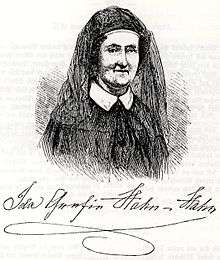Ida, Countess von Hahn-Hahn

Countess Ida von Hahn-Hahn (German: Ida Gräfin von Hahn-Hahn; 22 June 1805 – 12 January 1880) was a German author.
Biography
She was born at Tressow, in the duchy of Mecklenburg-Schwerin. She was the daughter of Carl Friedrich Graf (Count) von Hahn (1782 – 21 May 1857 Altona), who was well known for his enthusiasm for stage productions, upon which he squandered a large portion of his fortune. In his old age, he was obliged to support himself by managing a provincial company, and died in poverty. His father was Friedrich Graf von Hahn, a philosopher and astronomer.
In 1826, Ida married her wealthy cousin Friedrich Wilhelm Adolph Graf von Hahn, which gave her the doubled name. With him she had an extremely unhappy life, and in 1829, even before the birth of her mentally retarded daughter Antonie Gräfin von Hahn (1829–1856), her husband's irregularities led to a divorce. The existence of a second child, a son, by her partner and travelling companion Adolf Baron Bystram, supposedly born in 1830 and, like her daughter, put in someone's professional care, cannot be ascertained. The countess travelled, produced some volumes of poetry, and in 1838 appeared as a novelist with Aus der Gesellschaft, a title which, proving equally applicable to her subsequent novels, was retained as that of a series, the book originally so entitled being renamed Ilda Schönholm.

For several years, the countess continued to produce novels bearing a certain subjective resemblance to those of George Sand, but less hostile to social institutions, and dealing almost exclusively with aristocratic society. The author's patrician leanings at length drew upon her the merciless ridicule of Fanny Lewald in a parody of her style entitled Diogena. Roman von Iduna Gräfin H..-H.. (1847), and this, as well as the death of Adolf Bystram in 1849, and the revolutions of 1848 seem to have co-operated in inducing her to embrace the Roman Catholic religion in 1850. She justified her step in a polemical work entitled Von Babylon nach Jerusalem (1851), which elicited a vigorous reply from Heinrich Abeken, and from several others as well.
In November 1852, she retired into the Convent du Bon-Pasteur at Angers, France, which she, however, soon left in February 1853, taking up her residence at Mainz. There she founded with support of bishop Ketteler the convent ″Vom Guten Hirten″ beneath St. Stephen's Church, in which she lived from 1854 until her death there. She worked to reform outcasts of her own sex, but never joined the order, and continued her literary labours, producing Bilder aus der Geschichte der Kirche (3 vols., 1856–64), Peregrina (1864) and Eudoxia (1868).
Writings
For many years, her novels were the most popular works of fiction in aristocratic circles; many of her later publications, however, passed unnoticed as mere religious manifestoes. Ulrich and Gräfin Faustine, both published in 1841, mark the culmination of her power; but Sigismund Forster (1843), Cecil (1844), Sibylle (1846) and Maria Regina (1860) also obtained considerable popularity.
The posthumous papers of Ida Hahn-Hahn include around 730 autograph units, consisting of around 520 letters written by her and more than 180 letters written to her, as well as book and poetry manuscripts. Since 2007, they are part of the Fritz Reuter Literary Archive (Fritz Reuter Literaturarchiv) of Hans-Joachim Griephan in Berlin. The holdings include the correspondence, from 1844–1845, with Prince Hermann von Pückler-Muskau.
Her collected works, Gesammelte Werke, with an introduction by Otto von Schaching, were published in two series, 45 volumes in all (Regensburg, 1903–1904).
Notes
Regarding personal names: Gräfin is a title, translated as Countess, not a first or middle name. The masculine form is Graf.
Further reading
- Gert Oberembt, Ida Gräfin Hahn-Hahn, Weltschmerz und Ultramontanismus (Bonn, 1980)
Notes
References
 This article incorporates text from a publication now in the public domain: Chisholm, Hugh, ed. (1911). "Hahn-Hahn, Ida, Countess von". Encyclopædia Britannica (11th ed.). Cambridge University Press. This work in turn cites:
This article incorporates text from a publication now in the public domain: Chisholm, Hugh, ed. (1911). "Hahn-Hahn, Ida, Countess von". Encyclopædia Britannica (11th ed.). Cambridge University Press. This work in turn cites:
- Heinrich Keiter, Ida Gräfin Hahn-Hahn, ein Lebens- und Literaturbild (Würzburg, 1879–80)
- Paul Haffner, Gräfin Ida Hahn-Hahn, eine psychologische Studie (Frankfurt, 1880)
- Alinda Jacoby, Ida Gräfin Hahn-Hahn, Novellistisches Lebensbild (Mainz, 1894)
- Cayzer, Herlinde. Feminist Awakening in Ida von Hahn-Hahn's 'Graefin Faustine' and Luise Muehlbach's 'Aphra Behn.' (Brisbane, 2007).
 "Hahn-Hahn, Ida Marie Luise Sophie Friederike Gustave". The American Cyclopædia. 1879.
"Hahn-Hahn, Ida Marie Luise Sophie Friederike Gustave". The American Cyclopædia. 1879.